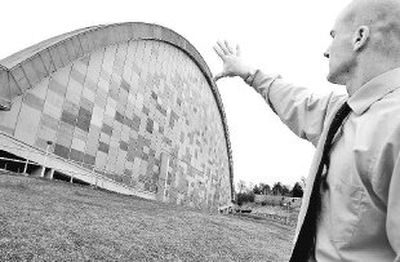UI to design new pavilion

BOISE – State education officials Thursday gave the University of Idaho the go-ahead to spend $1.6 million in federal grant money on designing an events pavilion on the Moscow campus and studying how to finance it.
The university may look to private donors to fund a 6,000-seat addition to its athletics complex to help accommodate sports and community events that now crowd the Kibbie Dome. Plans drafted recently also outline possible improvements to bring the 32-year-old wooden dome up to fire code.
The school also will replace the stadium’s 17-year-old turf football field, but it may need one-time state building funds or bonds to improve fire safety in the dome, college administrators told the State Board of Education.
University President Tim White said renovation and expansion are part of a “renaissance” on campus.
“The needs are very real,” he said. “This topic has my strong and unequivocal support.”
Administrators asked the state board last summer to study building the pavilion on the north side of the dome and upgrading the Kibbie facility. The U.S. Department of Housing and Urban Development granted the planning funds a few years ago, but the school needed permission to spend the money.
Plans also call for enhancements to the Vandal Athletic Center east of the dome, which would include new training facilities and tutoring services – amenities that officials hope will lure athletic talent.
Athletics Director Rob Spear called the sports facilities project the “most important topic we have going on in our athletic program today” and a vital part of the department’s vision.
Spear’s said the facilities don’t help when it comes to recruiting. “I think you all understand first impressions,” he said. “The first impression they get of our athletic facilities is not up to par with our peers.”
The basketball teams don’t get to play in the dome until well into the season because of scheduling conflicts. When the men’s basketball team faced Washington State University Dec. 9, the Vandals had practiced in the dome twice.
“That’s not much of a home-court advantage,” Spears said.
The Kibbie Dome is “nationally recognized as an achievement of civil engineering,” said Lloyd Mues, the university’s vice president for finance and administration. It hosts a multitude of events, from track and field meets and basketball games to this week’s Lionel Hampton International Jazz Festival.
“The use of these buildings and the latitude where we are is actually astonishing to me,” White said.
But the dome does not meet building codes. When construction began in 1972, the state didn’t have a fire marshal and the city didn’t have jurisdiction, so no permits were required, Mues said.
There are “a fair amount of life-safety issues, and we are aware of that,” he said.
Some safety enhancements, such as a smoke-detection system in the roof and better access to exits, have been made, he said.
“The challenge is truly what do we do, when do we do it, and how do we do it,” Mues added.
The university’s plans call for a new, portable-turf field that can be stacked as pallets rather than rolled against the wall, allowing for more exits. The new turf could cost as much as $2 million, Mues said.
Plans also include adding a mechanical smoke exhaust system and replacing the wooden east and west walls. The new walls would be translucent fiberglass panels in a steel structure.
Non-safety-related upgrades might include lowering the field to install new bleachers and give football fans in the first few rows a better view. That would create an additional 3,600 seats.
Board member Rod Lewis pointed out that a board policy prohibits spending university funds on the expansion.
“I think where you’re headed is a terrific place to go,” Lewis said, as long as administrators follow funding policies.
Students might also play a role in funding, said Humberto Cerrillo, the student-body president.
“We’re excited for the prospect of having an events pavilion on campus,” he said. “The students are ready. They’re ready to act.”